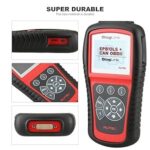It’s a common scenario: your check engine light illuminates, you use an OBD2 scanner to read the diagnostic trouble codes (DTCs), and then you might clear them. But what happens to those codes after you hit the reset button? Can they be retrieved? Understanding the nuances of the On-Board Diagnostics II (OBD2) system is crucial for car owners and enthusiasts alike. This article dives deep into whether codes can be retrieved after an OBD2 reset, exploring the different facets of OBD2 systems and data storage.
Decoding OBD2: How Your Car Logs Faults
The complexity of modern vehicles necessitates sophisticated diagnostic systems. OBD2, mandated in the USA for vehicles from model year 1996 onwards, is designed to monitor various vehicle systems, primarily emissions-related components. When something goes wrong, the vehicle’s computer, often the Engine Control Unit (ECU) or Powertrain Control Module (PCM), logs a DTC.
These DTCs aren’t just simple error messages. In most implementations, when a DTC is set, the system also captures a freeze frame of data. Think of it as a snapshot in time. This freeze frame contains a wealth of information known as Parameter IDs (PIDs). These PIDs cover a wide array of engine operating conditions at the precise moment the fault occurred. This includes:
- Engine RPM
- Vehicle Speed
- Oxygen Sensor Readings
- Mass Airflow Data
- Fuel Trims (Short and Long Term)
- Ignition Timing Advance
- Intake and Coolant Temperatures
- And many more parameters
Simple consumer-grade OBD2 scan tools often only display the basic “Pxxxx” DTC codes (accessed via OBD2 Mode 3). However, more advanced scan tools can access Mode 2 data, allowing technicians to view the invaluable freeze frame information, revealing the exact conditions when the DTC was triggered.
Pending vs. Stored: The Lifecycle of a DTC
OBD2 systems categorize DTCs to provide a clearer picture of vehicle health. There are primarily two categories:
- Pending Codes (Mode 7): These codes indicate a fault has been detected, but it hasn’t occurred consistently enough to trigger the check engine light immediately. The system needs to detect the fault condition again for a certain number of drive cycles before escalating it to a stored code and illuminating the check engine light (CEL). The number of drive cycles varies depending on the nature of the fault and the vehicle’s specific OBD2 implementation.
- Stored Codes (Mode 3): Also known as “logged” or “active” codes, these are confirmed faults that have met the criteria to illuminate the check engine light. By OBD2 definition, a stored code must trigger the CEL.
An OBD2 port in a car, highlighting its accessibility for diagnostic tools.
Historical Codes: Digging Deeper into the Past
Beyond pending and stored codes, some vehicles, particularly newer models with more sophisticated ECUs/PCMs, have the capability to store historical fault codes. These are records of past DTCs, even after they have been repaired and cleared. This historical data can be incredibly beneficial for experienced technicians, providing a background of intermittent issues or recurring problems, even when no current pending or stored DTCs are present. This feature’s availability depends heavily on the vehicle manufacturer and model year. Older vehicles, especially those from the early years of OBD2 implementation, may have limited historical logging capabilities.
Resetting OBD2: What Happens to the Data?
When you reset OBD2 codes using a scan tool or by disconnecting the battery (though the latter is generally not recommended for modern vehicles), you are essentially clearing the stored and pending DTCs. This action also typically turns off the check engine light. However, it’s crucial to understand what a reset actually does and doesn’t do:
- Clears Active Codes: Resetting the OBD2 system effectively clears the currently stored and pending DTCs that are causing the check engine light to be on.
- May Not Erase Historical Data: If the vehicle’s ECU is equipped with historical code memory, resetting the OBD2 system may not erase these historical codes. They could still be retrievable with a scan tool that supports accessing historical data. This is implementation-dependent and varies by vehicle.
- Resets Monitors: A significant consequence of resetting OBD2 codes is that it also resets the OBD2 monitors. Monitors are diagnostic tests that the vehicle runs to ensure various systems, particularly emissions systems, are functioning correctly. These monitors run either continuously or under specific driving conditions (drive cycles).
An OBD2 scanner tool being used to diagnose a vehicle.
Retrieving Codes After a Reset: Is it Possible?
So, going back to the original question: after an OBD2 reset, can the codes be retrieved? The answer is nuanced:
- Active/Stored Codes: Once you’ve successfully reset and cleared active or stored DTCs, standard OBD2 protocols (Mode 3) will not retrieve these cleared codes as active faults. They are gone from the “current fault” memory.
- Freeze Frame Data: Similarly, if the reset clears freeze frame data associated with those active codes (which is common), that specific freeze frame is also typically unrecoverable through standard OBD2 methods.
- Historical Codes (Potentially): If the vehicle stores historical codes in a separate memory location, and if your scan tool is capable of accessing this memory (often requiring a more advanced professional-grade tool), then it might be possible to retrieve some record of past faults even after a reset. However, this is not guaranteed and depends on vehicle-specific implementation.
In most common scenarios and with typical consumer-grade scan tools, once you reset OBD2 codes, the active codes and their associated freeze frame data are effectively gone and cannot be simply “retrieved” as if they were still active faults.
The Importance of Monitors and Emissions Readiness
Even if you clear DTCs and the check engine light goes off, resetting the OBD2 system has a crucial side effect: it resets the OBD2 monitors. These monitors need to run and complete their diagnostic tests over subsequent drive cycles to ensure all systems are functioning correctly. Until these monitors have run and passed, the vehicle is considered “not ready” for an emissions inspection.
This is why simply clearing codes before an emissions test is ineffective. The vehicle needs to go through several drive cycles, meeting specific criteria for each monitor to run (temperature, engine load, driving speed, etc.). Only when the monitors are complete and show a “ready” status will the vehicle pass an OBD2 emissions inspection.
Conclusion: Resetting is Not Erasing Everything, But Retrieval Has Limits
In conclusion, while resetting an OBD2 system clears active DTCs and turns off the check engine light, it’s not a complete erasure of all diagnostic information. Whether you can “retrieve” codes after a reset largely depends on what you mean by “retrieve.”
- Active, Stored Codes? No, they are cleared as active faults.
- Historical Codes? Potentially, if the vehicle stores them and you have the right tools.
- Evidence of Past Issues? Indirectly, yes, through the status of OBD2 monitors. A “not ready” status after a recent reset indicates codes were likely cleared and the vehicle needs to be driven to complete the monitor tests.
Understanding these nuances is vital. Resetting OBD2 codes can be useful after a repair, but it should not be used as a way to mask underlying problems, especially when facing emissions testing. If your check engine light comes on, it’s always best to properly diagnose and address the root cause of the issue rather than simply hitting the reset button and hoping it goes away permanently. Consulting a qualified mechanic is advisable for accurate diagnosis and repair.

